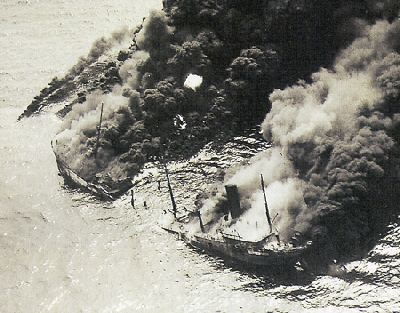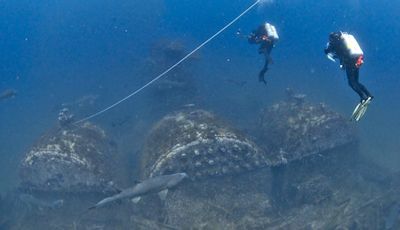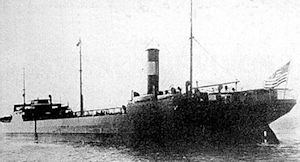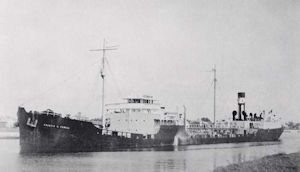 On March 26, 1942, the Dixie Arrow was traveling alone, approaching Cape Hatteras, enroute from Texas City, TX, to Paulsboro, N.J., with 96,000 barrels of crude oil. At 8:58 a.m., three torpedoes from a German U-boat slammed into the starboard side of the ship and in less than a minute the tanker cracked in two and was engulfed in flames. Eleven on board died. The 22 survivors were rescued and taken to Morehead City. The ship burned for more than a day and finally drifted onto the shoals at Cape Hatteras. Marine pilots from Cherry Point used the wreck for target practice. What was left was dragged offshore in 1944 and sunk in 43 feet of water, where it is now a favorite dive spot for recreational divers. Photos: Top, National Archives; Below, NOAA |
 |
HATTERAS — It is known to those diving off Cape Hatteras as the “slick wreck” because of the rainbow sheen on the water surface that reveals its resting place on the seafloor.
A 470-foot tanker carrying about 78,755 barrels of oil, the Lancing was steaming north past Diamond Shoals on April 7, 1942, when it was torpedoed by the Nazi submarine U-552. The engine room was struck, blasting a huge hole in its side and killing a crew member. The survivors managed to escape in four lifeboats before the ship sunk.
Supporter Spotlight
The vessel, lying nearly upside down on the bottom of the Atlantic about 14 miles off Hatteras, has likely been leaking oil for years.
According to a report released this spring by the National Oceanic and Atmospheric Administration, “2012 Risk Assessment for Potentially Polluting Wrecks in U.S. Waters,” there are 36 submerged vessels in U.S. waters that contain oil that could threaten the nation’s coastal marine resources. Of those, NOAA recommended 17 for further assessment and possible removal of the oil.
The Coast Guard has recently named the Lancing as a top priority in offshore North Carolina, along with four other wrecks in district waters, said Leonard Rich, environmental protection specialist for the Fifth Coast Guard District, which encompasses the Mid-Atlantic region from North Carolina to New Jersey.
Rich said that the Coast Guard, with the assistance of divers, boaters and fishers, will closely monitor the vessels for sheen and other signs of oil leaks. “The time we’re most concerned about getting reports is right after a hurricane,” he said.
The district’s other prioritized vessels are the Francis E. Powell off the Eastern Shore of Virginia, with 93,000 barrels of fuel oil; the William Rockefeller, off Cape Hatteras, with 150,000 barrels of fuel; the W.L Steed, off Cape May, with 78,000 barrels of fuel; and the China Arrow, off the Virginia/Delaware coast, with 93,000 gallons of fuel.
Supporter Spotlight
Oil sheen on the water has also been reported in the vicinity of the Francis. E. Powell and the Northern Pacific, which sunk off Cape May.
The NOAA report includes links to assessments for 87 vessels, ranked as high, medium and low priority, as well as its ranking for worst case discharge and most probable discharge.
Most of the 36 high risk wrecks cited in the NOAA report are located off North Carolina and Florida, victims of the German U-boat campaign in the early part of World War II that targeted merchant ships.
The tanker George McDonald, which went down off Savannah, Ga., in 1960 with 115,000 barrels of fuel, was also named a high priority in the Seventh Coast Guard District. Since the ocean currents typically move south to north, any oil release from the vessel has the potential to pollute North Carolina waters.
By comparing information from numerous government sources, scientific investigations, newspaper accounts, survivor and eyewitness reports and historic records, the initial 20,000 wrecks counted off U.S. coasts and the Great Lakes were methodically culled down to about 1,000, then finally 87.
In 2010, Congress appropriated $1 million for NOAA to identify the wrecks that presented the most risk to ecologic and economic interests from oil seepage or spills. The cultural and historic significance of the wrecks and whether they are gravesites were also considered, as well as the numerous laws in place governing protection and disturbance of the wrecks.
During the Battle of the Atlantic, when U-boats plucked off merchant vessels as if it were a turkey shoot, ships were typically lost in shallow coastal waters while transiting the wartime shipping routes. As a result, most of those vessels were demolished as navigational hazards or destroyed in later military training missions. Whatever oil they carried is long gone.
 The William Rockefeller was going to New York from Aruba through Torpedo Alley on June 28, 1942, carrying over 150,000 barrels of bunker “C” fuel oil, when the U-701 sent a torpedo into her port side amidships. A furious inferno ensued. The 44-member crew and her six-man Naval Armed Guard abandoned her about 15 minutes later. They all were rescued by the Coast Guard and taken to Ocracoke. The ship burned and drifted for 11 hours, and sank after the U-boat fired another torpedo into her. She is now on the NOAA priority list of potentially leaking wrecks. Photo: National Park Service |
 At 9:43 a.m. on Jan, 27, 1942, the unescorted Francis E. Powell was hit by a torpedo from U-130 off the Va. coast. The explosion started a small fire in the pump room and destroyed the radio antenna. The tanker sank about four hours later. The 28 survivors were rescued. The ship is also on the NOAA priority list. Photo: National Archives |
Of the 87 vessels NOAA developed risk assessments for, 47 of the vessels have unknown or unconfirmed locations, and 53 were casualties of World War I, World War II or the Korean War.
Lisa Symons, the resource protection coordinator for NOAA’s Office of National Marine Sanctuaries and an author of the report, said that it is difficult to determine just how much oil remains in each wreck, but that the report opted for a conservative estimate of more rather than less fuel.
Symons said that there has never been a massive spill from the sunken vessels – yet.
“We have not had a catastrophic release from any of these historic or legacy vessels in the U.S. or anywhere else in the world,” she said. But, she added, the potential is there. “These vessels are old – most are close to 50 years or more.”
The NOAA report is an extension of its Remediation of Underwater Legacy Environmental Threats project – RULET in government lingo — that generated a database of 573 sunken tankers, barges, freighters and other large vessels that carried varying amounts of oil. The agency said that the project is the first of its kind to include comprehensive risk assessments and prioritization on a number of wrecks. It also employed modeling for each wreck to project risks and conducted archaeological and engineering assessments to determine the condition of each and the potential for spillage.
“Before,” Symons said, “all we had was 20,000 dots on a map.”
The vessel information and location details in the report can be incorporated into the Coast Guard’s spill response plans, and would be helpful if any oil is observed, Rich said. “Our own Coast Guard aircraft and vessels, when they transit those areas and report
The Coast Guard also has an ongoing cooperative relationship with other federal, state and local agencies in monitoring oil spills, he said. If the port captain or the sector commander believes there is an imminent threat, he or she can request funds from the federal Oil Spill Liability Trust Fund, which is paid into by members of the shipping industry. Remediation is not permitted under the law without first having an imminent threat, Rich said.
Oil removal operations can be very costly and complicated, depending on the location of the wreck. But sometimes the benefits outweigh the expense, and monitoring can be a long-term expense that does not guarantee there won’t be a need for future pollution-related mitigation.
“It is important to consider,” the report said, “that for many wrecks, the most likely discharge scenario is one of chronic or episodic discharges that may result in multiple or continuous responses and ongoing and cumulative natural resource damages.”
Off California, for instance, the vessel Jacob Luckenbach created several spills over the course of a decade, costing millions in clean-up costs and oiling more than 51,000 birds.
The monitor-or-remove dilemma was summed up in a passage the report cited from the 2005 Oil Spill Conference Issue Paper on Potentially Polluting Wrecks in Marine Waters:
“Do we invest time and resources into sufficiently characterizing the pollution threat in order to support decisions on mitigating actions? Or, do we gamble on the capacity of the marine environment and its inhabitants, as well as our respective economies, to withstand any eventual release of oil pollution these wrecks may produce?”








